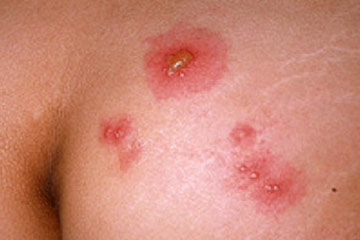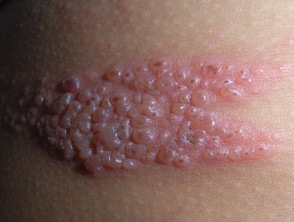Rabies Diagnosis
In animals, rabies is diagnosed using the direct fluorescent antibody (DFA) test, which looks for the presence of rabies virus antigens in brain tissue. In humans, several tests are required.
Rapid and accurate laboratory diagnosis of rabies in humans and other animals is essential for timely administration of postexposure prophylaxis.
Within a few hours, a diagnostic laboratory can determine whether or not an animal is rabid and inform the responsible medical personnel. The laboratory results may save a patient from unnecessary physical and psychological trauma, and financial burdens, if the animal is not rabid.
In addition, laboratory identification of positive rabies cases may aid in defining current epidemiologic patterns of disease and provide appropriate information for the development of rabies control programs.
The nature of rabies disease dictates that laboratory tests be standardized, rapid, sensitive, specific, economical, and reliable.
Diagnosis in animals
A diagnosis of rabies can be made after detection of rabies virus from any part of the affected brain, but in order to rule out rabies, the test must include tissue from at least two locations in the brain, preferably the brain stem and cerebellum.
The test requires that the animal be euthanized. The test itself takes about 2 hours, but it takes time to remove the brain samples from an animal suspected of having rabies and to ship these samples to a state public health or veterinary diagnostic laboratory for diagnosis.
In the United States, the results of a rabies test are typically available within 24 to 72 hours after an animal is collected and euthanized. Because rabies exposure to suspect animals is a medical urgency, but not an emergency, testing within this period is more than adequate for determining if a person was exposed to a rabid animal, and requires rabies postexposure vaccinations.
Approximately 120,000 animals or more are tested for rabies each year in the United States, and approximately 6% are found to be rabid. The proportion of positive animals depends largely on the species of animal and ranges from <1% in domestic animals to >10% of wildlife species.
Based on routine public health surveillance and pathogenesis studies, we have learned that it is not necessary to euthanize and test all animals that bite or otherwise potentially expose a person to rabies. For animals with a low probability of rabies such as dogs, cats, and ferrets, observation periods (10 days) may be appropriate to rule out the risk of potential human rabies exposure.
Consultation with a local or state health official following a potential exposure can help determine the best course of action based on current public health recommendations.
Diagnosis in humans
Several tests are necessary to diagnose rabies ante-mortem (before death) in humans; no single test is sufficient. Tests are performed on samples of saliva, serum, spinal fluid, and skin biopsies of hair follicles at the nape of the neck. Saliva can be tested by virus isolation or reverse transcription followed by polymerase chain reaction (RT-PCR).
Serum and spinal fluid are tested for antibodies to rabies virus. Skin biopsy specimens are examined for rabies antigen in the cutaneous nerves at the base of hair follicles
Direct fluorescent antibody test
The dFA test is based on the observation that animals infected by rabies virus have rabies virus proteins (antigen) present in their tissues. Because rabies is present in nervous tissue (and not blood like many other viruses), the ideal tissue to test for rabies antigen is brain. The most important part of a dFA test is flouresecently-labeled anti-rabies antibody.
When labeled antibody is incubated with rabies-suspect brain tissue, it will bind to rabies antigen. Unbound antibody can be washed away and areas where antigen is present can be visualized as fluorescent-apple-green areas using a fluorescence microscope. If rabies virus is absent there will be no staining.
Antigen detection by dFA
The rabies antibody used for the dFA test is primarily directed against the nucleoprotein (antigen) of the virus (see The Virus section on viral structure). Rabies virus replicates in the cytoplasm of cells, and infected cells may contain large round or oval inclusions containing collections of nucleoprotein (N) or smaller collections of antigen that appear as dust-like fluorescent particles if stained by the dFA procedure.
Histologic examination, General histopathology
Histologic examination of biopsy or autopsy tissues is occasionally useful in diagnosing unsuspected cases of rabies that have not been tested by routine methods. When brain tissue from rabies virus-infected animals are stained with a histologic stain, such as hematoxylin and eosin, evidence of encephalomyelitis may be recognized by a trained microscopist. This method is nonspecific and not considered diagnostic for rabies.
Before current diagnostic methods were available, rabies diagnosis was made using this method and the clinical case history. In fact, most of the significant histopathologic features (changes in tissue caused by disease) of rabies infection were described in the last quarter of the 19th century. After Louis Pasteur's successful experiments with rabies vaccination, scientists were motivated to identify the pathologic lesions of rabies virus.
Histopathologic evidence of rabies encephalomyelitis (inflammation) in brain tissue and meninges includes the following:
- Mononuclear infiltration
- Perivascular cuffing of lymphocytes or polymorphonuclear cells
- Lymphocytic foci
- Babes nodules consisting of glial cells
- Negri bodies
Negri bodies
In 1903, most of the histopathologic signs of rabies were recognized, but rabies inclusions had not yet been detected. At this time, Dr. Adelchi Negri reported the identification of what he believed to be the etiologic agent of rabies, the Negri body. In his report, he described Negri bodies as round or oval inclusions within the cytoplasm of nerve cells of animals infected with rabies. Negri bodies may vary in size from 0.25 to 27 µm. They are found most frequently in the pyramidal cells of Ammon's horn, and the Purkinje cells of the cerebellum.
They are also found in the cells of the medulla and various other ganglia. Negri bodies can also be found in the neurons of the salivary glands, tongue, or other organs. Staining with Mann's, giemsa, or Sellers stains can permit differentiation of rabies inclusions from other intracellular inclusions. With these stains, Negri bodies appear magenta in color and have small (0.2 µm to 0.5 µm), dark-blue interior basophilic granules.
The presence of Negri bodies is variable. Histologic staining for Negri bodies is neither as sensitive nor as specific as other tests. Some experimentally-infected cases of rabies display Negri bodies in brain tissue; others do not. Histologic examination of tissues from clinically rabid animals show Negri bodies in about 50% of the samples; in contrast, the dFA test shows rabies antigen in nearly 100% of the samples. In other cases, non-rabid tissues have shown inclusions indistinquishable from Negri bodies. Because of these problems, the presence of Negri bodies should not be considered diagnostic for rabies.
Immunohistochemistry (IHC)
IHC methods for rabies detection provide sensitive and specific means to detect rabies in formalin-fixed tissues. These methods are more sensitive than histologic staining methods, such as H&E and Sellers stains. Like the dFA test, these procedures use specific antibodies to detect rabies virus inclusions. The techniques use enzyme-labeling systems that increase sensitivity. In addition, monoclonal antibodies may be used to detect rabies virus variants.
Electron microscopy
The ultrastructure of viruses can be examined by electron microscopy. Using this method, the structural components of viruses and their inclusions can be observed in detail. Rabies virus is in the family of Rhabdoviruses. When viewed with an electron microscope Rhabdoviruses are seen as bullet-shaped particles.
Amplification methods
Samples containing small amounts of rabies virus may be difficult to confirm as rabies-positive by routine methods. Virus isolation in cell cultures increases the virus concentration because the virus replicates in cell cultures. Mouse neuroblastoma cells (MNA) and baby hamster kidney (BHK) cells provide an excellent environment for amplification of rabies virus without the use of animals.
Another method for amplifying the nucleic acid portion of rabies virus uses biochemical methods. With this procedure, rabies virus RNA can be enzymatically amplified as DNA copies. Rabies RNA can be copied into a DNA molecule using reverse transcriptase (RT). The DNA copy of rabies can then be amplified using polymerase chain reaction (PCR). This technique can confirm dFA results and can detect rabies virus in saliva and skin biopsy samples.
Accuracy of the tests
During the 50 years the direct fluorescent antibody (DFA) test has been used in the United States, there has been no indication it has failed to provide accurate clinical information on the rabies status of an animal for the purposes of treating an exposed person.
Because of its high sensitivity and specificity, in comparison to virus isolation methods, the DFA test is the "gold standard" diagnostic method for rabies and has been rigorously evaluated by international, national, and state health laboratories. The DFA test is currently the only recommended diagnostic method for routine rabies determination in animals in the United States.
During clinical disease, millions of viral particles may be found intermittently in the saliva. In theory, only a single rabies particle or virion is required to result in a productive infection.
The mass of a single virion has been estimated to be approximately 221 thousand kilodaltons. A small proportion of this amount includes viral RNA which accounts for less than 2% of the mass of a single virion.
Any rabies test proposed on living animals would need to be extremely sensitive to detect very minute quantities of protein or nucleic acid. In addition, several repeat tests would be needed over time to ensure that rabies virus excretion is not missed since viral shedding in the saliva is inconsistent. For example, more than 2 billion rabies virions would need to be present in a sample if a test had a sensitivity that was limited to detecting virus in the microgram (1,000,000th of a gram) range.
Related Articles
.
Autor: Dr. Carlos Muñoz Retana
Actualizado: 5 de Enero, 2019






